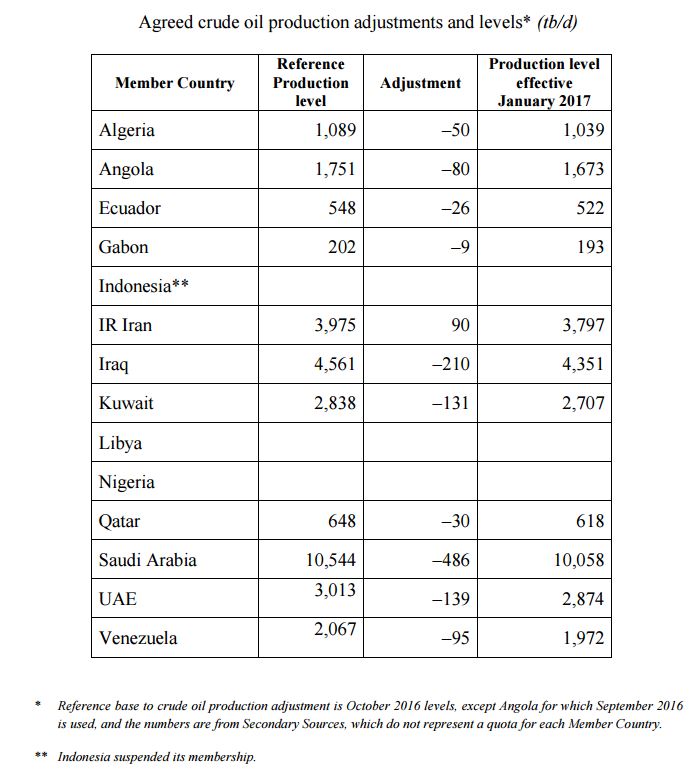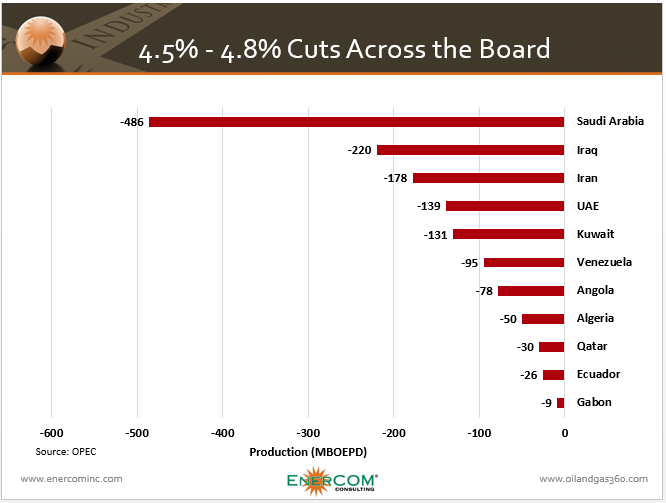“We have made great success today” – OPEC announces first cut since 2008
“We have made great success today. We reviewed all scenarios… [and] we have been able to reach an agreement,” Qatar energy minister and president of the OPEC Conference, Mohammed Bin Saleh Al-Sada said in the introduction to a press conference announcing a production cut by the Organization of Petroleum Exporting Countries.
“Today OPEC agreed in its scenario. But also OPEC has been in contact with key non-OPEC countries to participate in this agreement,” Al-Sada said.
In summary OPEC will reduce approximately 1.2 MMBOPD to 32.5 MMBOPD effective 1 January 2017.
“We agreed to share that reduction among OPEC countries. We took into consideration that some countries need special consideration. We did that unanimously,” Al-Sada said.
He said Indonesia would like to freeze or suspend their membership. “They are not withdrawing, they are suspending their membership. They think they will face difficulty in participating in the unanimous agreement in the OPEC decision.”
“This agreement includes a 600 MBOPD cut from non-OPEC countries. The Russian Federation agreed to reduce 300 MBOPD. Other countries have as well. There will be another similar press conference in Moscow to address this OPEC move to get the market rebalanced, the catalytic effect to rebalance the market.
“This is basically the summary of the agreement of today. This is a major step forward and we think that it is a historic moment to come to this agreement to rebalance the market and reduce the stock overhang.”
After the opening comments by Al-Sada, the meeting was opened to questions.
Reuters: Did the election of Donald Trump and [his stance on] the Iran agreement come up in discussions in the last few days?
OPEC: We are considering supply and demand and the stock overhang, but we don’t speculate fully on what would be the policies of the U.S.A. We take in the interest of consumers and of producers as well as the economy. We believe a fair price will benefit all. It will definitely move the economy above the 2% level.
Bloomberg: What is the new floor for production now that Indonesia has withdrawn? Is it 32.5 or is it a different number. I wanted to know if looking at it two years later, was that policy decision OPEC made in November 2014 a mistake.
OPEC: I wouldn’t classify it as a policy; it was a reaction to market circumstances in the best wisdom of OPEC and analysis from OPEC and external think tanks. We did discuss what is best. It never came to our mind that we are regretting what we did. We think what we did in OPEC has also advantages that production of oil and gas became in a more rational manner, more rational expenditure. A lot of high cost producers became more rational in their production. And it’s 32.5 MMBOD.
Q: How do you explain the floor still at 32.5 after Indonesia withdrawing, and is the non-OPEC binding or non binding?
OPEC: The news will be from Russia. Today and over the last few weeks we had intensive communications. Many countries are prepared to cut. Russia will take 300 MBOPD out of production. Russia is in support of our position. They said they would freeze originally, but they said they are willing to do more than that. We are open minded about other venues for the next meeting.
OPEC: Initially was requested to reduce by a certain amount. That amount has been distributed among the other countries.
THE ECONOMIST: You said the cut of 1.2 MMBOPD was subject to the 600 MBOPD by non-OPEC. If the non-OPEC won’t stay to that, does your agreement hold. What cut did Saudi Arabia agree to?
OPEC: The cut of 1.2 and the 600—we believe it is very much achievable. There will be a table distributed to you and I believe Saudi Arabia will cut around 486 MBOPD.
Q: Will the numbers on the table be described as allocations, quotas or temporary limits or other?
OPEC: We called them “adjustments” for the coming six months. We will come back and review it. We allowed in the agreement for a rollover of six more months. A committee consisting of five countries and the Secretary of OPEC will continuously monitor and submit a report. On May 25th we will meet again and that meeting is mainly meant to review the monitoring committee report. The intention is to extend it for six more months.
AMERICAN UNIVERSITY: Mr. Chairman, some analysts think that when oil production declines, there will be an increase in price that will benefit not OPEC but shale producers.
OPEC: The idea is to take measures to get the market rebalanced. We are not saying the rebalance will be from just OPEC and non-OPEC key members, but producers from outside will react to the price, but we cannot see a threat from shale gas and shale oil producers, because they will look at how much it will cost them, and the affordability. They will do it without us interfering. We think this measure will help rebalance. There will be effects on expensive producers, not only shale oil, but others.
CNN: You tried for agreements in April and in September. For the naysayers that said OPEC couldn’t deliver a deal what do you say and can the non-OPEC deliver the 600 MBOPD?
OPEC: We can get 300 from Russia and the others will announce it themselves. They showed commitment and we are assured we will get the 600, maybe more.
CNN: Many were concerned if OPEC was still relevant.
OPEC: I think without the OPEC presence and efforts to get momentum between OPEC and non-OPEC, such a responsibility; the amount of cooperation with non-OPEC countries made them like part of OPEC and what counts is movement. OPEC gathered the momentum and took the biggest share; that means the weight of OPEC and the resilience of OPEC is still there.
The press conference ended there. The OPEC agreement is available for download here.
Before the official announcement by OPEC, oil took off in early trading, rising 8%, based on reports that OPEC will announce a production cut to an output ceiling of 32.5 MMBOPD and Russia and other non-OPEC producers would contribute a cut of another 0.6 MMBOPD.

OPEC Agrees to a 1.2 MMBOPD Cut – prices of crude oil shot up in morning trading before the Nov. 28 OPEC announcement.
Saudi Arabia and regional rival Iran appear to have come to an agreement over production after the latter resisted cuts to production following the end of international sanctions. in advance of today’s press conference, a source inside the OPEC meeting told media that the group decided to suspend Indonesia from OPEC and allow Iran to set new production levels at 3.797 MMBOPD. Iran’s production was 3.69 MMBOPD in October, according to secondary sources.
Indonesia rejoined OPEC in June of 2015 despite being a net importer of crude oil.



